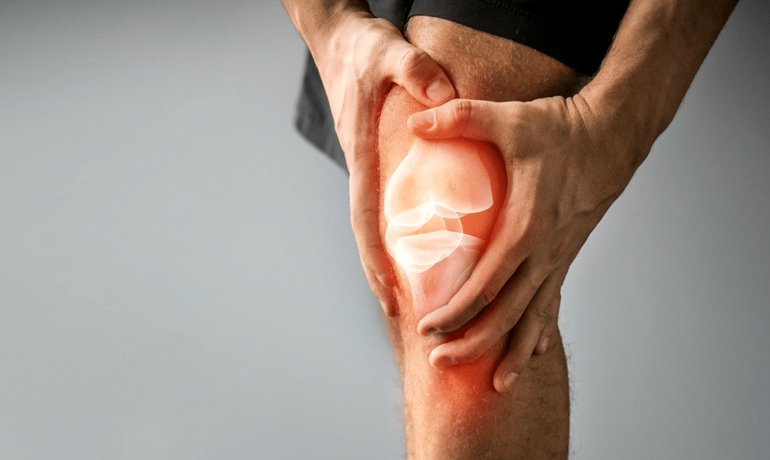Osteoarthritis (OA) is the most common form of arthritis, characterized by the gradual breakdown of cartilage—the protective tissue that cushions the ends of bones in joints. As the cartilage wears away, bones begin to rub against each other, causing pain, swelling, stiffness, and decreased mobility. OA can affect any joint but is most commonly found in the knees, hips, hands, and spine.
Causes of Osteoarthritis
-
Aging
- The risk of osteoarthritis increases with age as the cartilage naturally wears down over time.
-
Joint Injury
- Previous injuries, such as fractures, dislocations, or ligament damage, can lead to OA by altering the joint's structure and mechanics.
-
Repetitive Stress
- Occupations or activities that involve repetitive motion, heavy lifting, or prolonged standing can stress joints and contribute to OA.
-
Genetics
- A family history of osteoarthritis can increase the likelihood of developing the condition, as certain genetic factors can make cartilage more susceptible to damage.
-
Obesity
- Excess body weight puts additional stress on weight-bearing joints like the knees and hips, accelerating the wear and tear of cartilage.
-
Bone Deformities
- Some people are born with joint abnormalities or cartilage defects that can predispose them to osteoarthritis.
-
Other Diseases
- Conditions like diabetes, rheumatoid arthritis, and other inflammatory diseases can increase the risk of developing OA.
Symptoms of Osteoarthritis
- Pain: The most common symptom, pain in the affected joint usually worsens with activity and improves with rest.
- Stiffness: Joint stiffness, particularly in the morning or after periods of inactivity, is a hallmark of OA.
- Swelling: The joint may become swollen due to inflammation or the formation of bone spurs (osteophytes).
- Decreased Range of Motion: As the disease progresses, the joint may lose flexibility and movement becomes more restricted.
- Joint Crepitus: A grinding or clicking sensation in the joint during movement, caused by the rough surfaces of bones rubbing against each other.
- Tenderness: The joint may feel tender to the touch, especially around the edges.
Diagnosis of Osteoarthritis
-
Medical History and Physical Examination
- The doctor will review the patient’s symptoms, medical history, and perform a physical exam to assess joint function, range of motion, and signs of tenderness, swelling, or crepitus.
-
Imaging Studies
- X-rays: The most common imaging test for OA, X-rays can reveal joint space narrowing, bone spurs, and changes in bone structure.
- MRI: Magnetic resonance imaging may be used to provide a more detailed view of the cartilage, tendons, ligaments, and other joint structures.
-
Lab Tests
- Joint Fluid Analysis: In some cases, a sample of joint fluid may be analyzed to rule out other types of arthritis, such as rheumatoid arthritis or gout.
Treatment Options for Osteoarthritis
-
Non-Surgical Treatments
-
Medications:
- Pain Relievers: Acetaminophen and NSAIDs (ibuprofen, naproxen) are commonly used to manage OA pain.
- Topical Analgesics: Creams and gels containing NSAIDs or capsaicin can be applied to the affected joint for localized pain relief.
- Corticosteroid Injections: Injecting corticosteroids directly into the joint can provide temporary relief from inflammation and pain.
- Hyaluronic Acid Injections: Sometimes called viscosupplementation, these injections aim to lubricate the joint, though their effectiveness is debated.
-
Physical Therapy:
- Strengthening Exercises: Strengthening the muscles around the joint can help stabilize and protect it.
- Range of Motion Exercises: Stretching and flexibility exercises can improve joint mobility.
- Aquatic Therapy: Exercising in water can reduce stress on the joints while improving strength and flexibility.
-
Lifestyle Modifications:
- Weight Management: Losing weight can significantly reduce the load on weight-bearing joints like the knees and hips, easing symptoms and slowing disease progression.
- Activity Modification: Adjusting activities to reduce joint stress, such as using a cane or avoiding high-impact exercises, can help manage OA.
- Ergonomic Adjustments: Using supportive footwear, modifying workstations, and using assistive devices can help reduce joint strain.
-
Alternative Therapies:
- Acupuncture: Some patients find relief from OA pain through acupuncture, though evidence of its effectiveness is mixed.
- Supplements: Glucosamine and chondroitin supplements are often used by OA patients, but their effectiveness remains uncertain.
-
Surgical Treatments
- Arthroscopy: A minimally invasive procedure where a camera and small instruments are used to clean out the joint or repair damaged cartilage, though its benefit in OA is limited.
- Osteotomy: In cases where joint alignment is an issue, an osteotomy can involve cutting and realigning the bones to reduce stress on the joint.
- Joint Replacement (Arthroplasty):
- Partial Joint Replacement: Replacing only the damaged part of the joint, commonly used for knee OA.
- Total Joint Replacement: In advanced cases, the entire joint is replaced with an artificial implant. This is common for severe hip or knee OA.
- Joint Fusion (Arthrodesis): In severe cases where joint replacement is not possible, the bones on either side of the joint are fused together, eliminating movement but also pain.
Prevention of Osteoarthritis
- Maintain a Healthy Weight: Keeping a healthy weight reduces the strain on joints, especially weight-bearing ones like the knees and hips.
- Regular Exercise: Low-impact activities like swimming, cycling, and walking can help maintain joint function and muscle strength.
- Protect Joints: Avoiding joint injuries and practicing proper body mechanics during activities can help prevent OA.
- Healthy Diet: Eating a balanced diet rich in anti-inflammatory foods, vitamins, and minerals can support joint health.
- Early Treatment of Joint Injuries: Prompt and proper treatment of joint injuries can prevent long-term damage that might lead to OA.
Prognosis and Complications
- Progression: OA is a progressive disease, meaning symptoms may worsen over time. However, with appropriate management, many people can maintain an active lifestyle.
- Complications: Advanced OA can lead to significant disability, chronic pain, and reduced quality of life. Joint deformity and muscle weakness around the affected joint are also possible complications.
- Surgical Outcomes: Joint replacement surgery has a high success rate, often providing significant pain relief and improved joint function for many years.
